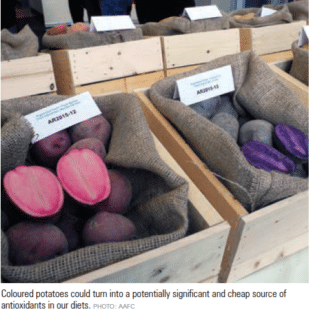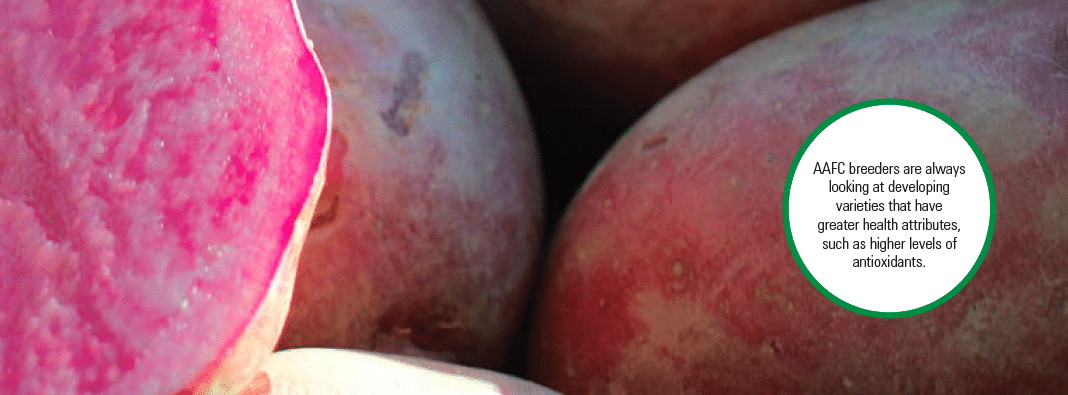[deck]Results from consumer studies will help industry stakeholders market potatoes.[/deck]
Gathering good information is important for any sector in meeting current and future market demands, and researchers at the University of Guelph and Agriculture and Agri-Food Canada are continuing to do just that with regard to conventional and pigmented potatoes.
Most consumers know by now that eating fruits and vegetables rich in antioxidants may decrease their chances of developing heart disease, cancer and more. Because potatoes are already such a popular food, coloured potatoes could turn into a potentially significant and cheap source of antioxidants in our diets, says Reena Pinhero, a research scientist at the Department of Food Science, University of Guelph.
Pinhero has been studying consumer response to potatoes for several years with her colleague Rickey Yada, who is also with the U of G’s Department of Food Science. Yellow potatoes are high in carotenoids, Pinhero says, and red, purple and blue tubers are rich sources of phenolic acids and anthocyanins.

“However, not much work has been done on sensory attributes of the pigmented potatoes,” she reports. “Phenolic acids are often bitter, acrid or astringent, and therefore it is important to conduct sensory evaluation and acceptance. And colour may affect the perception of sensory attributes such as aroma, texture and flavour.”
The study is part of an Ontario Ministry of Agriculture, Food and Rural Affairs project, and during the first two years, Pinhero and Yada cooked white, yellow, red and purple varieties in a few different ways to determine which method produces healthier glycemic index (GI) and glycemic load (GL).
The varieties, provided by Grand Bend Produce, are Adora, Yellow Star, Carlingford, Purple Fiesta, French Fingerlings, Ciklamen, Red Thumb and Smart.Vanessa Currie, a U of G technician in the Department of Plant Agriculture, and her colleagues helped Pinhero and Yada choose and source the varieties tested, so that, says Currie, the study “would reflect the new emerging varieties that are being developed.”
The processing methods were baking, boiling and cooling in the fridge at 4 C (retrogradation), followed by reheating in a microwave for one minute, and microwave cooking. The method of boiled-and-cooled was chosen for the recent sensory evaluation study, in which 65 people ranked the varieties by colour, flavour, texture and overall like or dislike. The results from this study will be used by the Ontario Potato Board for marketing purposes.
AAFC Consumer Preferences Evaluation
Sensory testing is also done by AAFC scientists and staff within the national potato breeding program based inFredericton, N.B. “We do a lot of testing and evaluation of consumer preferences in-house and we may outsource some of this in future to get a higher degree of validation,” says breeding program team member and molecular biologist, Virginia Dickison.

“We will be reviewing our procedures and consult with experts in this field to develop mechanisms to ensure that our varieties are as close as possible to what consumers desire. It’s part of making changes to the breeding program that will result in better links to industry partners and to consumers,” she says.
The team is also examining how the use of high-throughput analysis and DNA markers can help in the decisions of which chip, baking or table varieties to develop.
“AAFC potato breeders have done, and will continue to do, the breeding and science well, but we want to step up other aspects of the program,” saysAAFC breeder David De Koeyer.
“We have to make sure the commercialization aspects are strong so that the program remains competitive. Right now, less than 10 per cent of what’s grown in Canada are AAFC varieties, and it’s been over 20 per cent in the past, and we’d like to get back to that level. We recognize there’s a need to evaluate how the program has worked in the past, and we had an external review completed in September 2018.”
Any breeding program must develop breeding profiles that match market needs, and De Koeyer says 65 per cent of potatoes in Canada are used for processing, about 25 per cent go to the table/fresh market, and the rest are grown for seed.
Russet Burbank is still the main processing variety used in Canada, but it’s slowly being replaced by newer varieties, says De Koeyer, that are similar but have better disease resistance and mature earlier.
Russet Burbank itself can’t really be improved on as it is male sterile, and female parent plants are not very successful. De Koeyer notes that Russet Burbank “does have a packet of traits that are not easy to equal, but we have breeding material equal to it, and I would say that generally, breeders have done a lot to create varieties similar to it in processing quality and also in disease and pest resistance. That work continues.”
And while they do their best to meet the needs of growers for the chip market, AAFC breeders are always looking at developing varieties that have greater health attributes such as higher levels of antioxidants. Indeed, AAFC has released numerous varieties over the last few years to meet many areas of consumer desire. Benoît Bizimungu, leader of Canadian Potato Gene Resources at AAFC, says these include creamer types AR2011-06 (AAC Poppy) and AR2012-09 (AAC Island Ruby), pigmented AR2009-10 (AAC Blue Steele), AR2012-06 (AAC Cinderella) and AR2015-12 and AR2015-13 (both yet to be named, registration pending). “Since the ability to meet future needs depends also on available genetic diversity,” he says, “we are also working to revamp our gene resources research program.”
De Koeyer says the AAFC breeding program is evolving to build stronger ties with industry so that AAFC breeders are sure the attributes they are focussing on are the right ones. “This currently involves more meetings, using industry input to better refine product profiles, and getting that input — more feedback about new varieties — in terms of their strengths and weaknesses,” he says.
“We haven’t had that in the past to the degree we need. We need more feedback mechanisms in place to make sure the information is flowing back to us efficiently. We’re going to review the commercialization model of the last 20 years to make sure it still meets the needs of industry, and come up with more ways of promoting new selections.”
De Koeyer adds that he and his colleagues would actually like the program, in collaboration with industry, to produce a fresh variety that consumers can get to know and seek out in the grocery store for repeat purchases, as has happened to some extent with Yukon Gold.
Looking forward, De Koeyer believes “there’s a really good opportunity to make great breeding progress, to incorporate the technologies I’ve been working on throughout my career and apply them to the breeding program. Breeding is an incremental process and, retrospectively, I get a lot of satisfaction about seeing the progress that we’ve made. There are so many new technologies in genetics and information management we can make use of, and we can make breeding of potatoes as successful as any other crop. I am confident we are heading in the right direction.”
Editor’s Note: To learn more about the changes to the AAFC Potato Breeding Program, read Mark Halsall’s story “New Way Forward.”











